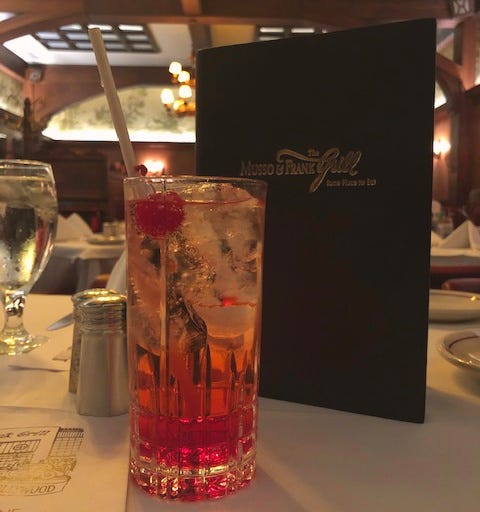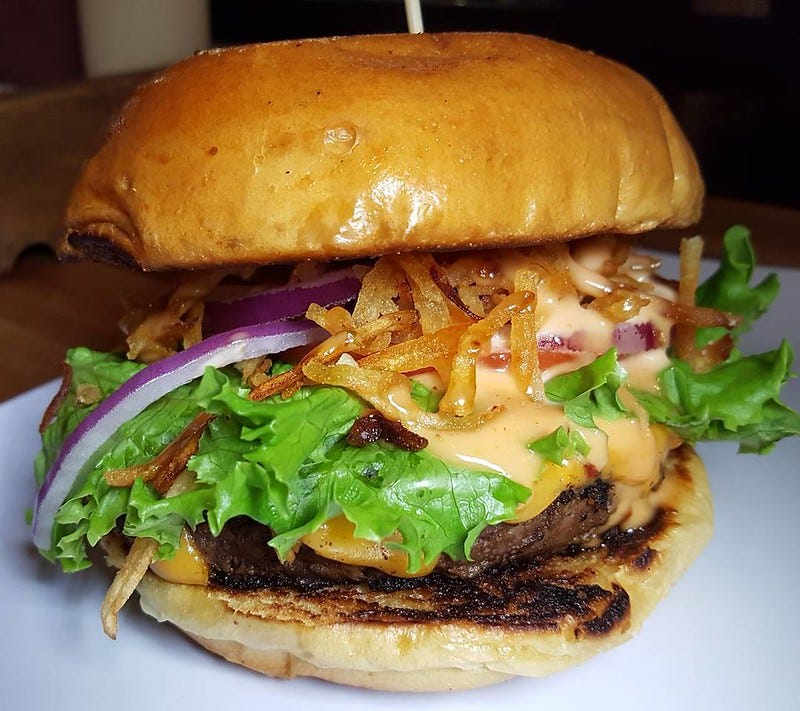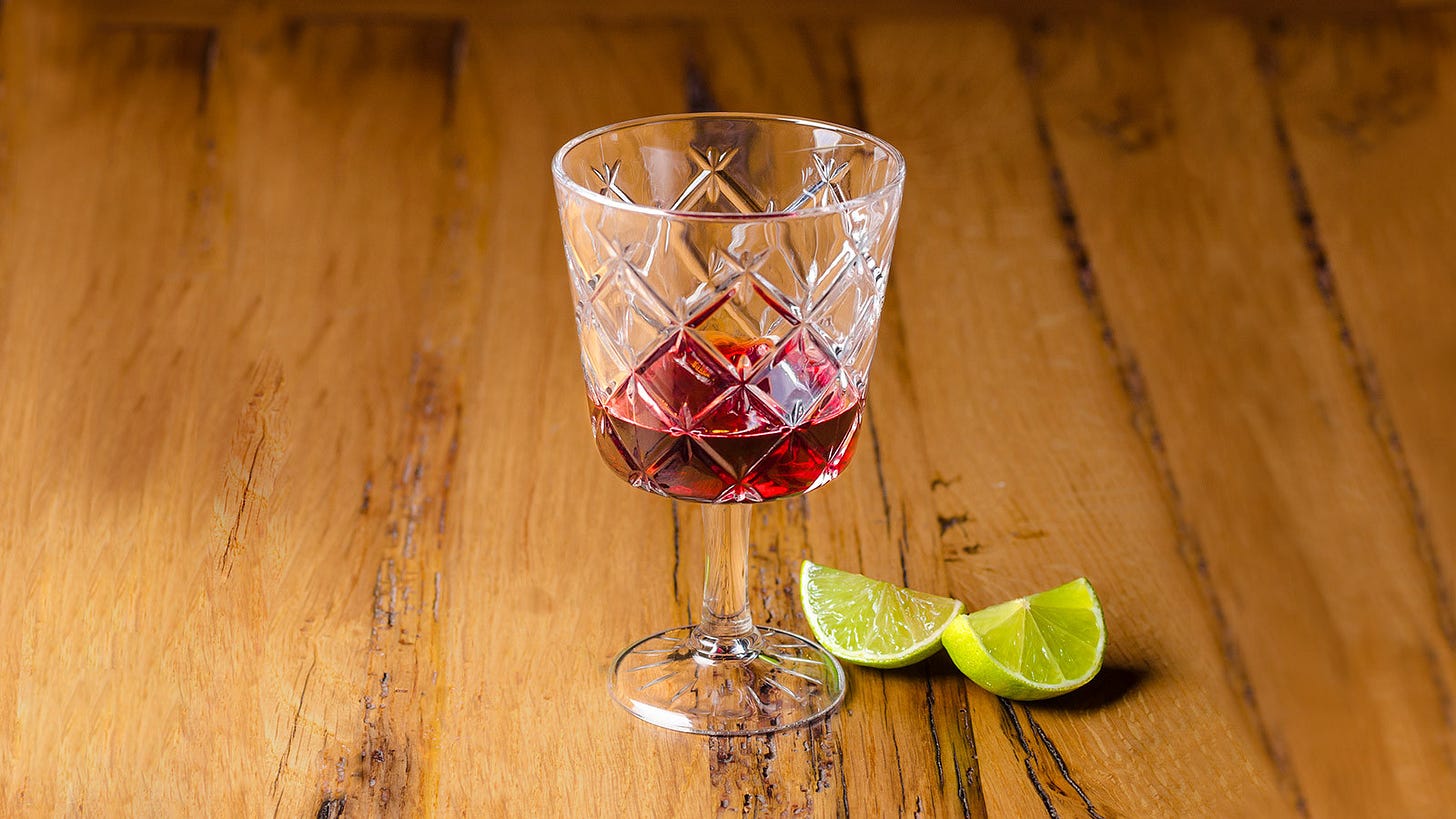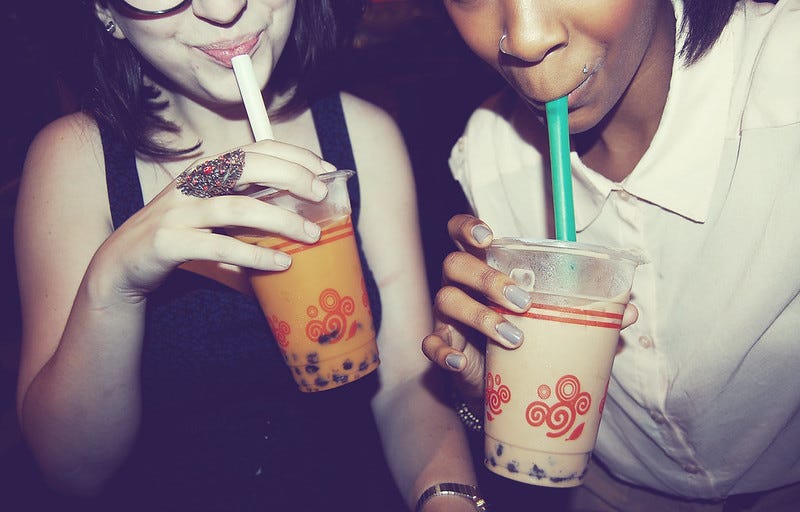Are we connected elsewhere? Say hi on: Instagram | Twitter | Facebook

Did you know there’s a maraschino liqueur-based cocktail called Angel’s Tit? I can’t see myself ordering that, but I have been getting into Shirley Temples lately. Look at this beaut from Musso & Frank, which has been open since before the namesake moppet was born. This journey was inspired by 1) new medication that makes one drink turn me into a coked-up flapper; 2) a recent episode about maraschino cherries. (You won’t believe it, but it has nothing to do with the little boy on Instagram called Shirley Temple King, who I will not be linking to, as I do not believe in famous children.)
I do believe in famous adults, though, so I had Flula on to talk about linzer tortes and various elements of German and Austrian history.
Click through to listen or stay here and read about burgers, wine, and another member of the sugary-drink family. - Katherine Spiers, editor and host

Secret Sauce Is Always Special
What elevates a burger? What makes this food more than the sum of its parts? Two words: secret sauce.
A good secret sauce is more than just a condiment. It is a feeling. With all the elements necessary to elevate a traditional burger, this more-than condiment is an amplifier. Fat. Acid. Salt. Sugar. The fat from mayonnaise slicks the tongue, while the acid from the mustard cuts through, a compelling counterpoint. Pickle, an essential element in any secret sauce worth its salt, offers ample pucker. Sweet? Look no further than ketchup, which provides, too, a signature pink color. Here, with the umami of the (cheese)burger itself, you have the touchstones of any spark of culinary joy, a food that pings every notable part of the palate, creating a round, unstoppable flavor.
The history of secret sauce is a sticky one. It’s impossible to trace its true provenance, though fast food restaurants were certainly elemental in propelling it to fame. In 1974, McDonald’s released an advertisement crowing that their burgers were topped with “special” sauce, made, among other ingredients (the recipe remains something of a secret), of mayonnaise, ketchup, and chopped pickle. Shortly thereafter, the West Coast’s Jack in the Box coined its own version: secret sauce. But the sauce dates back farther than that. In the late 1940s, the California-based burger chain In-N-Out began slathering its burgers—animal-style, of course—with its “spread,” a similarly pink and punchy burger sauce. Which is to say: Sauce on burgers is an American tradition that has dominated minds and palates for three quarters of a century.
Regardless of which burger outpost you align yourself with, you will find, in this mysterious sauce, a proprietary blend of ketchup, yellow mustard, mayonnaise, onion, and chopped pickle. You can tinker with it, of course, thereby making it your own. In my personal iteration, Worcestershire sauce makes a bold appearance, offering a beefy backbone that parallels the meat. There are arguments, among fans, for more or less mustard, more or less mayonnaise, more or less onion. There are versions made with sweet pickle relish (more sweet) and versions made with hand-chopped kosher dill pickles (more salty). Those are all valid opinions.
But what about those who shudder at the mere thought of mayonnaise? To them, I say, emphatically, that special sauce is no more mayonnaise than pasta is flour. A greater thing emerges from the marriage of all of these ingredients, a thing that transcends its single parts. Secret sauce need not be secret, though it is certainly always special. But, more importantly, it is a food that, thanks to both its simplicity and complexity, makes other foods better. There is genius inherent in this historic condiment. It’s just that good. 🍔
[What toppings are crucial to burger excellence? Tell everyone here.]

Photo: Croatian National Tourist Board
Croatia’s Secret Aperitif
By Amanda Mactas
Mystery shrouds the exact origins of bermet, an aromatic wine produced in Samobor, Croatia. Some say that Napoleon’s soldiers brought the recipe over from France, but nothing similar can actually be found in France. Others say that it dates back to the eighteenth century, when the pharmacists of Samobor started producing it for medicinal purposes.
Containing between 16 and 18 percent alcohol, this unique wine is typically enjoyed as an aperitif or digestif. The sweet bitter taste of the drink makes it instantly recognizable, thanks to its mix of grapes, Mediterranean fruits such as figs and carob, sugar, and wormwood, the herb responsible for the drink’s dominant bitter flavor. Bermet is a staple in Samobor culture, one of the only towns in which it can be found.
Only a handful of winemakers in the region still make this specialty wine, one of which, Family Filipec, has been producing bermet since the nineteenth century. It only produces between 6,000 and 7,000 bottles a year, most of which can be found in local restaurants, bars and gift shops, mostly in Samobor or the capital city, Zagreb.
Bermet’s longstanding popularity is due in part to its purported health benefits. It is said to help with loss of appetite, gallbladder disease, intestinal problems, muscle pain and, of course, loss of libido.
While primarily enjoyed on its own, bermet is also used in cocktails, as an added element to a gin and tonic, or topped off with prosecco. In the winter season, locals often add it into their coffee, dubbing it Samobor Coffee (not unlike Irish coffee). Bermet can also be used in cooking; it is a common pantry staple and added to sauces, marmalades, jams, and even salad dressings. But just start by drinking it as intended. An possibly ancient, definitely mysterious booze deserves it. 🍷

Photo: Flickr/mariahfleming
The Centuries-Long Rise of Boba Tea
Boba tea, also known as bubble tea or pearl milk tea, has become a ubiquitous treat across the U.S. in the past decade. But many don’t know it's been around in the U.S. since at least the ‘90s and that its roots go back centuries.
Milk tea’s history can be traced back as the Tang Dynasty (618-907 CE) when ingredients like butter, cream, and milk were said to have first been added to tea in China. As Europeans started arriving in China in bigger numbers in the 17th century, it’s reported that they took on the dairy habit too and brought milky tea home with them. The practice died out in China, but was then reintroduced by Europeans in the 19th century.
The tapioca found in milk tea today comes from starch derived from the South American cassava plant that arrived in Taiwan during the period of Japanese rule (1895-1945). It was already a Chinese and Southeast Asian tradition to eat jelly-like desserts, like sago pearls (made from spongy insides of palm trees), so creating tapioca pearls was an easy next step. The tapioca starts as hard, tasteless, and white starch balls. They are boiled in bubbling vats of caramelized sugar for hours, until cooked into black, sweet pearls. The texture of the boba pearls is itself a signature quality known as “Q” or “QQ” texture in Taiwan. It’s that addictive, chewy, springy consistency that’s also found in sweet, savory, hot, and cold Taiwanese dishes, like rice cakes, noodles, fish cakes, and dumplings. It’s a cornerstone of Taiwanese cuisine.
The fusion of the two traditions—milk tea and the gelatinous pearls—is the boba tea we know today. Two rivaling Taiwanese teahouse chains, Hanlin Tea Room and Chun Shui Tang, both claim to this day they came up with the combination in the early ‘80s. Though the origins are unclear, there’s one thing that most people are certain about: the name “boba” refers to Hong Kong’s ‘80s sex symbol Amy Yip, whose nickname was “Boba,” which translates to “breasts.”
Not long after its creation, the drink made its way to the U.S., partly due to Congress passing the Immigration and Nationality Act of 1965. The act abolished an immigration policy that restricted many ethnic groups, including Asians, and caused waves of Taiwanese families to immigrate to the U.S from the ‘60s to the ‘90s. In particular, Los Angeles served as a hotspot for Taiwanese immigrants to relocate, and boba culture began spreading in the early ‘90s. Entrepreneurs began opening storefronts and restaurants that served boba tea as a cheap post-meal drink served in Styrofoam cups.
The popularization of the new school boba tea shops has been compared to the emergence of third-wave coffee shops, but another parallel explanation is the evolution of Chinese American restaurants. Many of the new boba shops are opened by first and second-generation Asian Americans that adapt Western aesthetics and styles. Instead of selling it as a cheap afterthought, they repackaged boba tea as a cute, tasty drink that wasn’t limited to dessert.
The boba tea industry has grown in the last decade and entered into the mainstream, and there are no signs of its popularity slowing. In 2016, Allied Market Research valued the global boba tea market at $1.9 billion, and sales are expected to reach $3.2 billion by 2023. But despite its rising popularity, boba tea hasn’t necessarily sold out. While still catering to Western styles, there are also new innovations of boba tea found in the U.S., like cheese tea and brown sugar boba, that follow Asian trends, proving that boba serves as a bridge between the two countries. 🎆
[Learn even more about boba in this episode with Chris Fleming, who loves it so much he named his most recent tour Boba Everyday.]
Read these:
Berkeley’s ongoing reputation as a hotbed of “California cuisine” is partly due to the grocery store/mecca known as Berkeley Bowl. Sarah Belle Lin wrote an obituary of the co-founder, Glenn Yasuda.
Michelle García wrote a beautifully-done feature about the food stalls at a tent camp on the U.S.-Mexico border. You will finish it a more empathetic person.
This newsletter is edited by Katherine Spiers, host of the podcast Smart Mouth.
Please forward to a food-loving friend!
A TableCakes Production.



